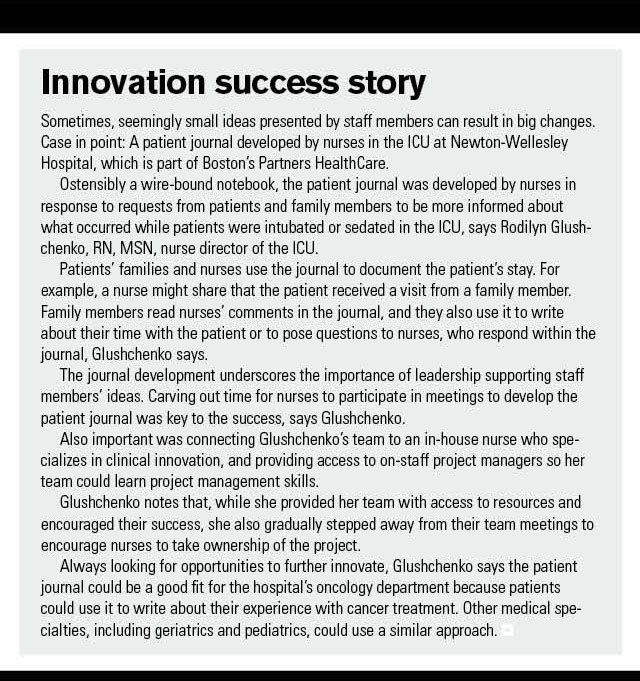Four Ways to Spur Innovation at Your Managed Care Organization
This first article in our new leadership series explores how managed care executives can cultivate smart ideas and stay ahead of the competition.
Click to enlarge

Click to enlarge

Click to enlarge

Every year in the United States, approximately 700 women die due to pregnancy or childbirth-related causes, according to the CDC-and that’s despite the fact that 17 cents of every dollar is spent on healthcare, according to 2012 numbers from the Organization for Economic Cooperation and Development.
This and other pressing healthcare challenges-such as the need to encourage appropriate adoption of new treatments including immunotherapy-mean the industry is ripe for creative thinking and innovation, says Managed Healthcare Executive Editorial Advisor Don Hall, principal of DeltaSigma LLC, a consulting practice specializing in strategic problem solving for managed care organizations.
“We have to start finding innovators in our business,” he says. “We have to start creating innovative cultures, because the opposite is really what we have in our industry. [Healthcare] cultures tend to be very conservative-and focused on reducing risk.”
Here are four recommendations from Hall and other experts regarding how you can spark creative programs and solutions at your organization.
1. Create a “sponsorship spine.”
Julie Coffman, a partner at consulting firm Bain & Company, recommends forming a leadership cadre that carries forth changes ushered in by innovative researchers and physicians. Coffman cites the example of a young physician-researcher with a breakthrough therapy that he’s working hard to get the facility to embrace. Enabling the physician-researcher’s success starts with connecting him to individuals who can help move the project up the chain, she says. Make sure your organization has a system in place to encourage this type of partnership between individuals and leadership who have already demonstrated the ability to encourage organizational adoption of innovation, says Coffman. “The key to effective change management, in lots of ways, is developing the early victories, being able to talk about them, and celebrating them with the right people that carry a lot of sway in the organization-and then allow the cascade to naturally be pulled, as opposed to pushing it on people who might be resistant to change their behavior without feeling the need,” she says.
2. Consult frontline employees who work one-on-one with customers.
Hall laments that far too many employees are never asked for insight on improving the customer experience-and that means their valuable ideas never arrive in the executive suite.
3. Focus on empowerment, not accountability.
At many organizations, prioritizing accountability has become a key management philosophy, says Joe Tye, CEO and head coach at Values Coach training and consulting firm. He says that tends to discourage employees from taking creative approaches to solving problems. While Tye, who previously served as chief operating officer at The Toledo Hospital in Ohio and Baystate Medical Center in Worcester, Massachusetts, admits that managers must be held accountable for budgets and nurses must be held accountable for the care they provide to patients, he insists that using only “carrots and sticks” to hold people accountable isn’t going to encourage them to solve problems creatively. “When leaders clearly define expectations for what I call the ‘Invisible Architecture’ of core values, organizational culture, and workplace attitudes, they rarely have to hold people accountable hierarchically with carrots and sticks because it’s accomplished through the peer pressure of cultural accountability,” says Tye.
4. Use insight from customers to drive more enlightened decision making.
“No one is calling an insurance company to compliment them,” says Hall. “Nobody is calling to say, ‘I love this product.’ They’re telling you about a problem they’re having.” Whether customers are looking for more online access to providers or quicker access to lab results and treatment recommendations, those problems need to be addressed in the executive suite, he says.
Aine Cryts is a writer based in Boston.

Chief Pharmacy Officer Jason R. Smith on the Challenges Health Systems Face
May 28th 2025Jason R. Smith, Pharm.D., appointed as chief pharmacy officer in February 2025 for the University of Rochester Medical Center, talks about building a stronger workforce, managing drug shortages and keeping up with changes in regulations because of the new administration.
Read More
Extending the Capabilities of the EHR Through Automation
August 2nd 2023Welcome back to another episode of "Tuning In to the C-Suite," where Briana Contreras, an editor of Managed Healthcare Executive, had the pleasure of chatting with Cindy Gaines, chief clinical transformation officer at Lumeon.
Listen